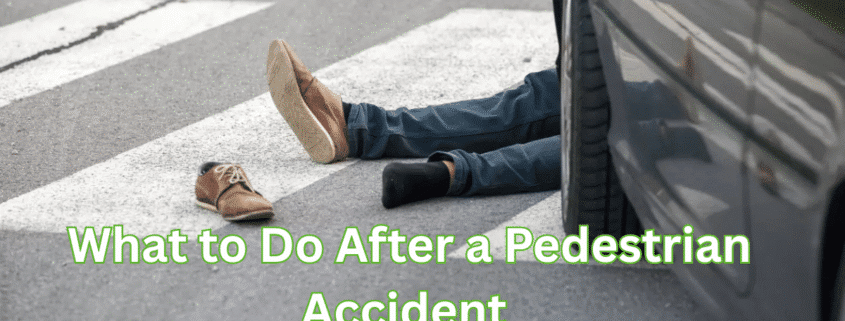What to Do After a Pedestrian Accident?
Right after an accident, first call the police helpline. Get medical care, keep pictures and witness names, and file a police report. Save all medical bills and notes. Tell your insurer only the basics. Talk with a local lawyer before giving recorded statements.
Your perspective can change in the seconds it takes for a car, truck or other vehicle to strike you as you walk. You’re possibly in a bit of pain and not sure what you should do next.
The first few hours matter for your health and any later claim. Following simple steps like getting medical care, keeping photos, and filing an official report makes things easier for later proceedings.
Due to various queries, we are going to provide this detailed guide. It lets you know about clear, practical steps you can follow right after the crash and in the days after. It also explains how to track bills, when to speak to an insurance company, and when to get a local pedestrian lawyer involved.
Let’s start the blog.
Summary of main points:
- If anyone is injured, call the authorities.
- Get checked by a doctor within a day.
- Take photos of the scene and your injuries.
- Collect witness names and contact details.
- File a police report.
- Tell insurers basic facts only.
- Keep a daily symptom and expense log.
- Save every medical bill and receipt.
- Deadlines can block your claim later.
- Talk to a local lawyer early.
Step #1: Get to safety and call for help
Becoming the first victim after a crash or any kind of accident, your survival safety should be the first task to consider. And only after that, other concerns such as help, health and the consequences of the incident could be thought about.
The arrival of the police should be followed with a thorough explanation of the events that led to the accident. In an instance of conflict with the driver, do not argue and drive away. Besides which, don’t alter your story regarding where you were, what direction you were walking and if you used a crosswalk.
With your phone, snap a visual of the vehicle, its plate, your shoes, the street sign, any marks that can be seen on the road or any other things that are related to the accident. People that have seen the accident should stay until the police arrive or at least get their name and phone number written down. If not, they might not be useful later on. Thus, doing little things now can have a great impact on your health and the money you’ll get in case of filing a claim later.
Step #2: See a doctor right away and follow up
After getting to a safe place, your next step is to see the doctor. Ignoring any type of pain (even if it is minor) is not good for your health and financial claim. With proper medical reports, you have solid proof.
When you visit the doctor, describe every symptom in detail. You should also include your headache or any scratch. Gather all the documents including test results, bills, prescriptions, and referral notes.
Step #3: File a police report and keep the record
A police report is an official snapshot of the crash. If officers are called to the scene, they will prepare that report on your behalf. You should file a police report as soon as possible if they do not. Clearly explain the facts and provide any photographs or witness contacts that you have collected.
Request a copy of the report along with the report number. This report generally comprises the name of the driver, the insurance details, and any citations he or she has received. Police reports serve as a tool for insurance companies and lawyers to confirm the facts of the incident. If it’s a hit-and-run situation, ensure that the police are documenting the event as such. This will not only help the investigators in finding the driver but also it will be advantageous for your case later on.
Step #4: Gather and protect evidence at the scene
All these things should be bagged at the scene and backed up as soon as possible.
- Pictures of the damage to you and your car.
- Close-up of the license plate and model of the car.
- Images of traffic signs, crosswalks, and skid marks.
- Name, driver’s license number and insurance information of the driver.
- The names and phone numbers for any witnesses.
Don’t discuss fault at the scene; let the police determine fault.
Step #5: Tell your insurer, but be cautious with statements
You should notify your insurance company of the crash. Even if you were a pedestrian. Tell the main facts like when, where, and that you were struck by a vehicle. Insurers may ask for a recorded statement. You do not have to give one. If an adjuster from the other driver’s company asks for a recorded account, say you will respond after talking to a lawyer.
Keep any communications short and factual. Save every email and voicemail. Do not accept a quick cash offer without checking how much your care and lost pay will cost. Insurance firms sometimes look for fast, low payouts. A lawyer can advise whether an early offer is reasonable.
Step #6: Track medical care and expenses carefully
It is advisable to save all the crash information in one place, such as a folder. Besides that medical bills, test results, prescriptions, receipts for medical supplies, and travel costs should not be left out. Documents showing wages that have been lost such as pay stubs or a letter from your employer confirming workdays that you have missed should be kept as well. Writing a journal every day will help you keep track of your pain, sleep problems, and limitations.
Even small entries such as “could not lift baby” or “could not cook dinner” demonstrate how injuries have altered your life. Writing a journal is one of the ways that help in determining a fair price for pain, suffering, and loss of enjoyment. If you are short of money, payment plans may be an option. In case you are filing a lawsuit, some companies may delay the issuing of bills.
Step #7: Pick a local pedestrian injury lawyer
Selecting an accident attorney that has experience in dealing with pedestrian accidents that have gone through Utah courts is a smart decision. If you are unable to go and see them in person, find out how they keep you updated with the progress of your case and how many similar cases they have handled. Client testimonials and fee inquiries are also good things to do. Also, ensure that the person you select clarifies things and is available when you need to talk with them. Contact Cockayne Law for a dedicated support.
Final thoughts
Pedestrians may cause a feeling of being uneasy and confused. Keep photos, witness names, and every bill. Report the crash to your insurer, but do not give long recorded statements before talking with a lawyer. Time limits in Utah mean you should act without delay if you plan to pursue a claim. A good pedestrian accident lawyer in Utah relieves much of the stress by handling evidence collection, insurer talks, and court work if needed. Keep your focus on recovery and keep good records. Those small, organized steps are what make a strong case later.
FAQs
Is it necessary to see a doctor if I feel fine?
Yes. Some injuries show up later. A medical exam creates records that link your condition to the crash. That helps both your health and a later claim.
How long do I have to sue in Utah?
For most injury claims you usually have four years to file suit, but government claims and some situations require quicker notice. Check with a local lawyer to avoid missing deadlines.
Should I give a recorded statement to the other driver’s insurer?
Avoid recorded statements until you talk with a lawyer. Keep any insurer communication short and factual. Insurers may use statements to lower payouts.
Can I still recover if I was partly at fault?
Possibly. Utah reduces recovery by your percentage of fault. Even if you share blame, you may still get money. A lawyer can assess how fault affects value.
How do lawyers charge for pedestrian cases?
Many work on contingency. That means you pay legal fees only if you recover money. Ask about fee rates and costs before hiring.
What if I cannot afford medical care now?
Whenever possible, use health insurance and keep your EOBs. Check with providers about payment plans. Lawyers can assist in arranging settlement payments later.









